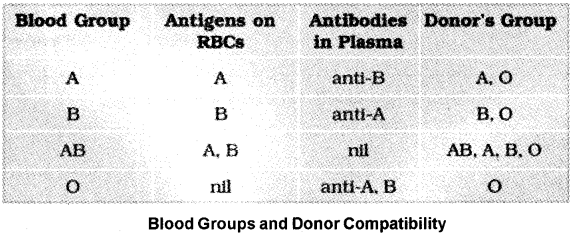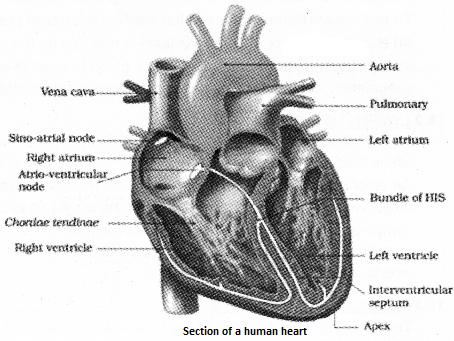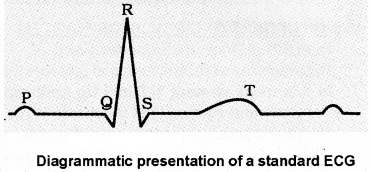Kerala Plus One Zoology Notes Chapter 7 Body Fluids and Circulation
Blood
Blood is a special connective tissue that contains
- Fluid matrix
- Plasma
- Formed elements.
Plasma:
It constitutes nearly 55 percent of the blood. 90 – 92 percent of plasma is water and proteins (Fibrinogen, globulins and albumins) contribute 6 – 8 percent of it. Fibrinogens are needed for clotting or coagulation of blood.
Defence mechanism and osmotic balance:
Globulins primarly are involved in defense mechanisms of the body and the albumins help in osmotic balance. Plasma also contains small amounts of minerals like Na+, Ca++, Mg++, HCO3–, CI–, etc. Factors for coagulation or clotting of blood are also present in the plasma in an inactive form.
What is serum?
Plasma without the clotting factors is called serum.

Formed Elements
- Erythrocytes
- Leucocytes
- Platelets
They constitute nearly 45 per cent of the blood.
1. Erythrocytes or red blood cells (RBC):
They are the most abundant and on an average, 5 millions to 5.5 millions of RBCs mm-3 of blood. RBCs are formed in the red bone marrow in the adults. RBCs are devoid of nucleus in most of the mammals and are biconcave in shape. They have a red coloured, iron containing complex protein called haemoglobin.
A healthy individual has 12 – 16 gms of haemoglobin in every 100 ml of blood. These molecules play a significant role in transport of respiratory gases. RBCs have an average life span of 120 days after which they are destroyed in the spleen (graveyard of RBCs).
2. Leucocytes:
They are also known as white blood cells, colourless, nucleated and are relatively lesser in number which averages 6000 – 8000 mm-3 of blood. Leucocytes are generally short lived. The two main categories of WBCs granulocytes and agranulocytes.
| Neutrophils, eosinophils and basophils are different types of granulocytes, while lymphocytes and monocytes are the agranulocytes. |
- Neutrophils are the most abundant cells (60 – 65 percent) of the total WBCs and basophils are the least (0.5 – 1 percent) among them.
- Neutrophils and monocytes (6 – 8 per cent) are phagocytic cells which destroy foreign organisms entering the body.
- Basophils secrete histamine, serotonin, heparin, etc., and are involved in inflammatory reactions.
- Eosinophils (2 – 3 per cent) resist infections and are also associated with allergic reactions.
Lymphocytes (20-25 percent) are of two major types – ‘B’ and ‘T’ forms. Both B and T lymphocytes are responsible for immune responses of the body.
3. Platelets:
They are also called thrombocytes, are cell fragments produced from megakaryocytes (special cells in the bone marrow). Blood normally contains 1,500,00 – 3,500,00 platelets mm-3. Platelets are involved in the coagulation or clotting of blood. A reduction in their number can lead to clotting disorders which will lead to excessive loss of blood from the body.
Blood Groups
AB, O, and Rh- are widely used all over the world.
ABO grouping
It is based on the presence or absence of two surface antigens on the RBCs namely A and B. The plasma of different individuals contain two natural antibodies (proteins produced in response to antigens). There are four groups of blood, A, B, AB and O.

Who are called as universal donor and receipient?
The group ‘O’ blood can be donated to persons with any other blood groupand hence ‘O’group individuals are called ‘universal donors’. Persons with ‘AB’ group can accept blood from persons with AB as well as the other grbups of blood, such persons are called ‘universal recipients’.
Rh grouping
Rh antigen is observed on the surface of RBCs of majority (nearly 80 percent) of humans. Such individuals are called Rh positive (Rh+ve) and without antigen are called Rh negative (Rh-ve). Rh group should also be matched before transfusions.
What is Rh incompatibility?
It is the mismatching of blood between the Rh-ve blood of a pregnant mother with Rh+ve blood of the foetus. Rh antigens of the foetus do not get exposed to the Rh-ve blood of the mother in the first pregnancy as the two bloods are well separated by the placenta.
But during the delivery of the first child, there is a possibility of mixing of the maternal blood to small amounts of the Rh+ve blood from the foetus. In such cases, the mother starts preparing antibodies against Rh in her blood. In subsequent pregnancies, the
| Rh antibodies from the mother (Rh-ve) can leak into the blood of the foetus (Rh+ve) and destroy the foetal RBCs. This causes severe anaemia and jaundice to the baby. This condition is called Erythroblastosis foetalis. |
Solving of Rh incompatibility:
This can be avoided by administering anti-Rh antibodies to the mother immediately after the delivery of the first child.
Coagulation of Blood
Blood coagulates or clots in response to an injury or trauma to prevent excessive loss of blood from the body. The network of threads called fibrins in which dead and damaged formed elements of blood are trapped.
Fibrins are formed by the conversion of inactive fibrinogens in the plasma by the enzyme thrombin. Thrombins are formed from another inactive substance present in the plasma called prothrombin.
An enzyme complex, thrombokinase, is required for the above reaction. An injury stimulates the platelets in the blood to release certain factors which activate the mechanism of coagulation. Calcium ions play a very important role in clotting.
Lymph (tissue fluid)
As the blood passes through the capillaries in tissues, fluid released out is called the interstitial fluid or tissue fluid. It has the same mineral distribution as that in plasma. An elaborate network of vessels called the lymphatic system collects this fluid and drains it back to the major veins.
The fluid present in the lymphatic system is called lymph. Lymph is a colourless fluid which are responsible for the immune responses of the body. Lymph is also an important carrier for nutrients, hormones, etc. Fats are absorbed through lymph in the lacteals present in the intestinal villi.
Circulatory Pathways
The circulatory patterns are of two types – open or closed.
Open circulatory system:
It is present in arthropods and molluscs in which blood pumped by the heart passes through large vessels into open spaces or body cavities called sinuses.
Closed circulatory system:
It is present in Annelids and chordates in which the blood is pumped by the heart circulated through a closed network of blood vessels.
All vertebrates possess a muscular chambered heart.
1. Fishes have a 2-chambered heart with an atrium and a ventricle.
2. Amphibians and reptiles (except crocodiles) have a 3-chambered heart with two atria and a single ventricle.
3. Crocodiles, birds and mammals possess a 4-chambered heart with two atria and two ventricles. In fishes the heart pumps out deoxygenated blood which is oxygenated by the gills and supplied to the body parts from where deoxygenated blood is returned to the heart (single circulation).
In amphibians and reptiles, the left atrium receives oxygenated blood from the gills/lungs/skin and the right atrium gets the deoxygenated blood from other body parts. However, they get mixed up in the single ventricle which pumps out mixed blood (incomplete double circulation).
In birds and mammals, oxygenated and deoxygenated blood received by the left and right atria respectively passes on to the ventricles of the same sides. The two separate circulatory pathways are present in these organisms, hence the animals have double circulation.
Human Circulatory System
Heart:
It is situated in the thoracic cavity, in between the two lungs. It is protected by a double-walled membranous bag, pericardium, enclosing the pericardial fluid. It has four chambers, two small upper chambers called atria and two larger lower chambers called ventricles.
A thin, muscular wall called the inter atrial septum separates the right and the left atria, whereas a thick-walled, inter-ventricular septum, separates the left and the right ventricles. The atrium and the ventricle of the same side are separated by a thick fibrous tissue called the atrioventricular septum.
Tricuspid and bicuspid valve:
The opening between the right atrium and the right ventricle is guarded by a valve formed of three muscular flaps or cusps, the tricuspid valve. Bicuspid or mitral valve guards the opening between the left atrium and the left ventricle.
Semilunar valve:
The openings of the right and the left ventricles into the pulmonary artery and the aorta respectively are provided with the semilunar valves.
Function of semilunar valve:
It allows the flow of blood only in one direction, i.e., from the atria to the ventricles and from the ventricles to the pulmonary artery or aorta. These valves prevent any backward flow.
SAN & AVN:
A specialised cardiac musculature called the nodal tissue is also distributed in the right upper corner of the right atrium called the sino-atrial node (SAN). Another mass of this tissue is seen in the lower left comer of the right atrium close to the atrio-ventricular septum called the atrioventricular node (AVN).
A bundle of nodal fibres, atrioventricular bundle (AV bundle) continues from the AVN which passes through the atrio-ventricular septa to emerge on the top of the interventrical sepyum and divides into a right and left bundle. These branches give rise to minute fibres throughout the ventricular musculature, they are called purkinje fibres.
These fibres alongwith right and left bundles are known as bundle of HIS. The nodal musculature has the ability to generate action potentials without any external stimuli.

What is the pacemaker of heart?
The SAN can generate the maximum number of action potentials, i.e., 70 – 75 min-1, and is responsible for initiating and maintaining the rhythmic contractile activity of the heart. Hence it is called the pacemaker. Our heart normally beats 70 – 75 times in a minute (average 72 beats min-1).
Cardiac Cycle
As the tricuspid and bicuspid valves are open, blood from the pulmonary veins and vena cava flows into the left and the right ventricle respectively. The semilunar valves are closed at this stage. The action potential is conducted to the ventricular side by the AVN and AV bundle from where the bundle of HIS transmits it through the entire ventricular musculature.
This causes the ventricular muscles to contract, (ventricular systole), the atria undergoes relaxation (diastole). As the ventricular pressure increases the semilunar valves open, allowing the blood in the ventricles to flow through these vessels into the circulatory pathways.
The ventricles relax (ventricular diastole) and the ventricular pressure falls causing the closure of semilunar valves which prevents the backflow of blood into the ventricles.
This sequential event in the heart which is cyclically repeated is called the cardiac cycle and it consists of systole and diastole of both the atria and ventricles. The heart beats 72 times per minute,i.e., that many cardiac cycles are performed per minute.
| The duration of a cardiac cycle is 0.8 seconds. During a cardiac cycle, each ventricle pumps out approximately 70 mL of blood which is called the stroke volume. The stroke volume multiplied by the heart rate (no. of beats per min.) gives the cardiac output. |
Cardiac output is the volume of blood pumped out by each ventricle per minute and averages 5000 mL or 5 litres in a healthy individual.
Sound produced in heart:
For example, the cardiac output of an athlete will be much higherthanthat of an ordinary man. During each cardiac cycle sounds are produced, the first heart sound (lub) is associated with the closure of the tricuspid and bicuspid valves whereas the second heart sound (dub) is associated with the closure of the semilunar valves. These sounds are of clinical diagnostic significance.
Electrocardiograph (ECG)
ECG is a graphical representation of the electrical activity of the heart during a cardiac cycle. Each peak in the ECG is identified with a letter from P to T that corresponds to a specific electrical activity of the heart.
1. The P-wave represents the electrical excitation Diagrammatic presentation of a standard ECG (or depolarisation) of the atria, which leads to the
contraction of both the atria.
2. The QRS complex represents the depolarisation of the ventricles, which initiates the ventricular contraction. The contraction starts shortly after Q and marks the beginning of the systole.
3. The T-wave represents the return of the ventricles from excited to normal state (repolarisation). The end of the T-wave marks the end of systole.
| By counting the number of QRS complexes that occur in a given time period, one can determine the heart beat rate of an individual. |
Since the ECGs obtained from different individuals have the same shape any deviation from this shape indicates abnormality or disease.

Doube Circulation
It involves two types of circulation,
1. Pulmonary circulation:
The deoxygenated blood pumped into the pulmonary artery is passed on to the lungs from where the oxygenated blood is carried by the pulmonary veins into the left atrium. This pathway constitutes the pulmonary circulation.
2. Systemic circulation:
The oxygenated blood entering the aorta is carried by a network of arteries, arterioles and capillaries to the tissues from where the deoxygenated blood is collected by a system of venules, veins and vena cava and emptied into the right atrium. This is systemic circulation.
The systemic circulation provides nutrients, O2 and other essential substances to the tissues and takes CO2 and other harmful substances away for elimination. A vascular connection between the digestive tract and liver called hepatic portal system.
The hepatic portal vein carries blood from intestine to the liver before it is delivered to the systemic circulation. In Coronary system of blood vessels is present in our body exclusively for the circulation of blood to and from the cardiac musculature.

Regulation Of Cardiac Activity
Normal activities of the heart are autoregulated by specialised muscles (nodal tissue), hence the heart is called myogenic. Medulla oblongata control cardiac function through the autonomic nervous system (ANS).
Neural signals through the sympathetic nerves (part of ANS) increase the rate of heartbeat. On the other hand, parasympathetic neural signals decrease the rate of heartbeat. Adrenal medullary hormones can also increase the cardiac output.
Disorders Of Circulatory System
High Blood Pressure (Hypertension):
Hypertension is the term for blood pressure that is higher than normal (120/80). In this measurement 120 mm Hg (millimeters of mercury pressure) is the systolic, or pumping, pressure and 80 mm Hg is the diastolic, or resting, pressure. High blood pressure leads to heart diseases and also affects vital organs like brain and kidney.
Coronary Artery Disease (CAD):
Coronary Artery Disease, often referred to as atherosclerosis, affects the vessels that supply blood to the heart muscle. It is caused by deposits of calcium, fat, cholesterol and fibrous tissues, which makes the lumen of arteries narrower.
Angina:
It is also called ‘angina pectoris’. A symptom of acute chest pain appears when no enough oxygen is reaching the heart muscle. It occurs due to conditions that affect blood flow.
Heart Failure:
It is the state of the heart when it is not pumping blood effectively enough to meet the needs of the body. Heart failure is not the same as cardiac arrest (when the heart stops beating) or a heart attack (when the heart muscle is suddenly damaged by an inadequate blood supply).
